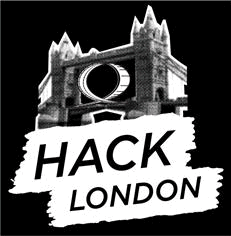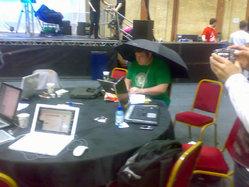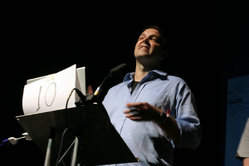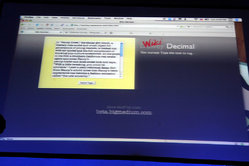Lightning! Blimps! Submarines! And, um, Machine Tags!
By
Josh Clark
Published Jun 18, 2007

Lightning struck (twice!). Rain followed. Submarines mobilized. Tomatoes flew. Yahoo knitted. Dr. Who descended. Werewolves prowled. Rabbits flagged semaphore. Blimps flew (kind of). And friends, much code was hacked.
Well. That was awesome. I’m bleary-eyed but totally energized after London’s Hack Day. Over 500 developers turned up for the 24-hour hackfest, and in the end, over 70 projects were presented.
I was particularly charmed by Ann McMeekin’s “buzz knit” hack to generate knitting patterns from the content of Yahoo news feeds (“maybe one day I’ll knit my blog”). And like pretty much everyone in the room, I was floored by Steffan Jones’ prize-winning Mac dashboard gadget to show you a slideshow of photos related to the songs playing in iTunes. (Steffan, when are you going to release that baby?)

The event was thoroughly engaging and altogether humbling. The amount of know-how, creativity and sheer geekery in the room was overwhelming, a potent reminder of how much there is left to learn. It’s a feeling that provokes both anxiety and inspiration. Mostly inspiration. It’s just plain exciting to be part of a profession and community whose frontiers are expanding so fast. So much to explore.
And yeah, the frontier spirit was very much in evidence. Organizers and participants good-naturedly weathered an unlikely collection of setbacks. We battled the elements for an hour or two after a freak lightning strike wigged out the fire system and opened giant vents in the ceiling, letting the rain into a very electrified venue. (“Uh, does anyone here know anything about fire prevention computer systems?” asked event co-organizer Matt Cashmore). What’s a visit to London without a little rain? And, oh yeah, the network was down for several hours.
Through it all, though, there was a palpable sense of enthusiasm and generosity that set it apart from any conference I’ve attended. The London geek community is a fun crowd, affable hosts to those of us visiting from countries across Europe.
Look what I made

Mine was a modest hack, a little web app that generates machine tags to describe any text content that you throw at it.
Machine tags work just like regular tags, except that they’re specially formatted to include data that can be understood by software. This means that they tend to be much more descriptive and accurate than traditional tags. You can use them to associate data with a specific map location, airplane model, just about anything.
So my idea was to create a machine-tag format based on Wikipedia topics, allowing any content creator to tag content with any topic in Wikipedia. By using Wikipedia as an index, this format provides very specific identification of content across a vast knowledge domain. Call it the Dewey Decimal System for the web: “The Wiki Decimal System.”
In general, the problem with machine tags is how to make them easy to add for regular folks. Although the format itself is simple, the tags are typically lengthy and require you to know the data ID for what you want to tag.
Enter my hack: A web page that takes your text and builds the list of Wikipedia machine tags automatically.
A card catalog

As it turned out, figuring out and building the tags was a cinch. The challenge was figuring out a good interface for displaying and editing them. In the end, though, I was really proud of the elegance of the final interface, definitely the most interesting part of the project. I wish I’d shown off the interface a bit more in my presentation, but I sped through it when panic set in at the approach of my 90-second limit. Whaddya gonna do?
Anyhoo… the tag generator finds all of the phrases that seem important in your text and displays each phrase as a library catalog card. Click the tab of the card to view it (and again to return it to the stack).
Each card contains three links to Wikipedia pages related to that phrase. If any of those pages are not important to your text, click the link’s delete button to remove it. If the entire phrase isn’t relevant, you can likewise remove the entire card from the stack. The list of corresponding machine tags is updated as you make these changes.
Want more tags? Just submit new text, and more cards are added to the stack.
Give it a try yourself: The Wikipedia Machine Tag Generator is online here.
And there are photos of my 90-second presentation here, here, here, here, here, here.
June 19 update: I just added a quick explanation of both the app and the tag format, linked from the web app page. I’ll do a more formal explanation of the project later, but this should at least provide a basic orientation for newcomers.
What’s next: Machine tags and me
I had a really pleasant chat with Chris Sizemore of the BBC and Rachel Lovinger of Razorish after the presentations. It seems they’ve also been thinking about how to tag content using Wikipedia. We’re all interested in promoting adoption of this (or a similar) tag format, and I’m hoping we’ll explore it further.
My weekend hack might also be a good starting point as a prototype for how to make it as painless as possible for content creators to machine-tag their content. Whatever I wind up doing with machine tags, I had a great time building this little gizmo over the weekend. Hack Day was a terrific event with a genuinely warm spirit and an inspiring level of brain power. I learned a lot, I met interesting folks, and I’m already looking forward to next year, assuming the organizers are willing to brave the lightning again.





